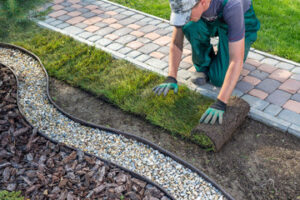Denver Roofing Companies are one of the most important parts of any house. It protects everything inside the house from rain, snow, wind and other weather elements.
Roofs are typically made of shingles, either asphalt, wood or clay/terra cotta. There are also solar roof options now available. Regardless of material, a good roof will last a long time with little maintenance other than periodic inspections and removing debris such as moss.

Weather protection is a critical part of any construction project. It’s important that the worksite remains protected from rain, snow, sunlight and other harsh weather conditions. These conditions can make the work difficult and even dangerous for workers, so it’s essential that proper construction weather protection is available at the jobsite.
Roofing is the process of covering the top surface of a building with a waterproof layer of material. Typically, this is achieved by interlocking sheets of ply sheeting with bitumen. The bitumen is usually asphalt, tar or a cold-applied adhesive. Asphalt and tar require heating before they can be applied to the roof, while cold-applied adhesives don’t.
APAC offers a variety of high-quality construction weather protection solutions, including metal flashing weather proofing, weather-resistant barriers and lead weather proofing. Contact us today to learn more about our products and services. We’re always happy to provide advice and recommendations based on your specific needs. Our experts are well versed in the industry and can find you exactly what you’re looking for. We’ll also help you determine the best method of protection for your specific site and environment.
Energy Efficiency
The roof is a key component in the thermal regulation of buildings. Energy-efficient roofing solutions are designed to effectively insulate homes and regulate temperature levels, reducing the strain on artificial heating and cooling systems. As a result, this type of roofing reduces energy consumption and costs, offering numerous benefits for homeowners and businesses alike.
Choosing the right materials is crucial for energy-efficient roofing. Various roofing materials can have varying effects on energy use, so homeowners should be sure to research the potential impact of each option. For example, metal and clay tiles offer excellent insulation properties and can help minimize heat transfer. They can also reflect sunlight instead of absorbing it, keeping the interior cooler and lowering the need for air conditioning.
Energy-efficient roofs are also made from recycled materials, thereby decreasing the demand for raw resources and minimizing waste. As a result, these types of roofs are highly sustainable and provide a strong return on investment for homeowners.
Many homeowners also report a reduction in their energy bills following the installation of an energy-efficient roof, making them a great choice for those looking to save money on utilities while making a positive impact on the environment. In addition, these roofs can also extend the lifespan of HVAC systems by reducing their load, thereby protecting investments in this essential piece of household equipment.
Homeowners can further contribute to the conservation of energy and the environment by integrating solar panels into their roof. This will allow them to generate their own electricity, reducing reliance on fossil fuels and contributing to the mitigation of climate change.
The energy efficiency provided by roofing can be significant, especially for those living in hot areas. As a result, many people are turning to cooling technologies like cool roofs to help mitigate their energy costs and protect their homes from the extreme summer temperatures. Cool roofing consists of a layer of reflective shingles, tiles, or coating that reflects sunlight rather than absorbs it. This helps keep the interior of a building cooler and reduces the need for air conditioning, helping to cut energy costs and lower utility bills.
Durability
Depending on the material, roofing lasts from 15 to 20 years for flat roofs to 50 or more for slate and metal. Often, the lifespan of a roof can be extended with regular maintenance and by having leaks repaired immediately. Leaks are usually caused by a problem at a penetration such as a plumbing vent or skylight, and fixing this can extend the life of your roof.
Tile roofs – particularly concrete or clay tiles – have one of the longest average lifespans for a roof, lasting 50 to 100 years or more. However, they can be expensive and heavy, requiring a home to have special framing and supports and requiring homeowners to consult with a structural engineer before installation.
Wood shakes offer rustic beauty and insulating value, and can last 30 years or more when properly maintained. However, they are more prone to fire damage than metal or tile roofs.
Aesthetics
Roofing materials can provide aesthetics to homes and buildings. Some of these aesthetics are obvious, while others are subtler and less visible to the naked eye. For example, a roof may feature pleasing shapes, colors, movement, patterns, scale and visual weight. The aesthetics of a design are important in that they make a design more appealing to the eye and, thus, increase its usability. Aesthetics play an important role in architectural and urban planning, but they also contribute to the general feel of a home or building.
The scope of aesthetics has been broadened in recent decades to include not only works of art but natural objects and phenomena, built structures and even human activities. One reason for this broader definition of aesthetics has been the growing prominence of ecological and environmental concerns in Western philosophy, as well as a revival of interest in popular art and architecture (Vihalem 2016).
It is important to recognize that some everyday experiences are more aesthetic than others. For example, certain qualities – messiness, shabbiness, cuteness and prettiness – are experienced as aesthetic but are not appreciated in the same way as a painting or a flower garden. This is because these experiences do not require the same level of background knowledge, aesthetic sensibility and reflective process as a work of art.
Moreover, some people do not consider these experiences to be worthy of being the subject of an aesthetic inquiry. In some cases, this is due to the dominance of judgment-oriented discourse in mainstream Western aesthetic theory. This mode of inquiry tends to consider anything that does not involve a judgment as hopelessly subjective and relativistic.
However, a phenomenological approach to aesthetic experience has emerged in response to this limitation. This approach focuses on the sensory dimensions of aesthetic experience and does not require a judgment-oriented framework. Rather, it provides a theoretical foundation for understanding how and why certain qualities are perceived as aesthetic by some and not by others.
The emergence of everyday aesthetics has been accompanied by increased efforts to blur the distinction between art and life. This movement has been facilitated by the growing availability of digital technology that allows for the replication of real-life events and objects in the form of simulations. This has allowed for a proliferation of art installations that re-create aspects of daily life. It has also led to a shift in the emphasis placed on non-Western cultural traditions as a source of inspiration for the development of everyday aesthetics.
Stucco Roofing
Stucco is an exterior cement plaster wall covering that has long been popular for residential and commercial structures. The material has a natural appeal and is durable enough to protect your home against the elements. It can be painted or stained to match your home’s color scheme, and it is easy to maintain. However, stucco is not always the best choice for heavy rains or snow, as water can seep through the surface and cause damage.
When properly maintained, a stucco roof can last for decades and is a good choice for any climate. The material is also non-combustible and fire-resistant, which can help protect your family and belongings in the event of a fire. It is also a great insulator and can keep your home cooler in hot weather and warmer in cold weather. In addition, stucco is resistant to insects and other pests, making it a great option for homes in wooded areas.
There are several different types of stucco, including rock dash and smooth stucco. Rock dash stucco has a rough texture that adds contrast to your home’s design, while smooth stucco is more refined and subtle. Smooth stucco is more popular for modern houses because it is easier to clean and maintain. Both types of stucco are available in a variety of colors, so you can choose the one that best complements your home’s style and surroundings.
It is important to inspect your stucco regularly for cracks and other signs of damage. If left unchecked, these issues can lead to moisture and water leaks that can wreak havoc on the interior of your home and damage valuable items. In addition, cracks in the stucco can allow heat and air conditioning to escape, which can increase your energy bills.
Stucco can be applied to a number of different surfaces, including wood framing and light-gauge steel framing. If your home has a wood frame, we recommend putting on a waterproof barrier such as an asphalt-saturated paper or a manufactured plastic-based sheet called a building wrap before applying the stucco. On flat or rubber membrane roofs, we can put on a layer of tarpaper or plastic taped down with masonite, and then apply the stucco.




